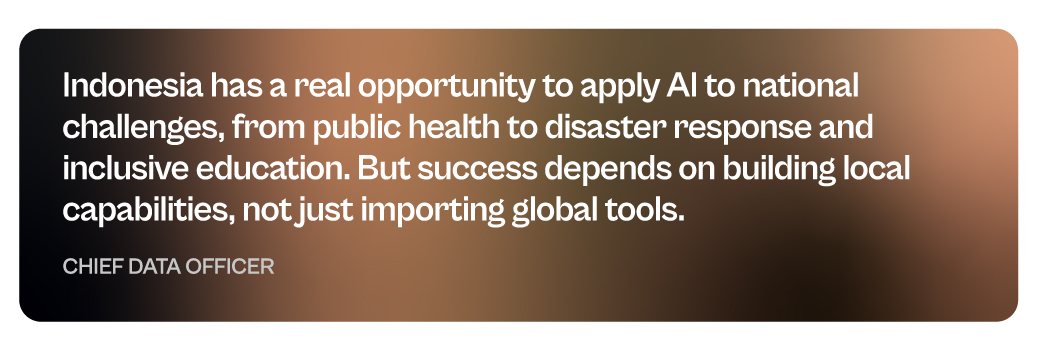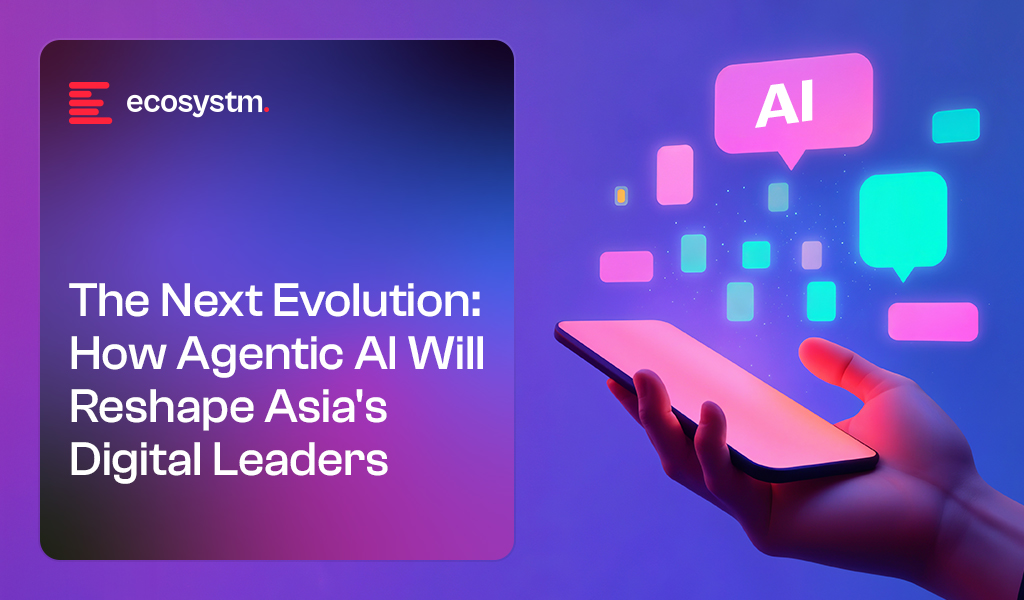Indonesia’s vast, diverse population and scattered islands create a unique landscape for AI adoption. Across sectors – from healthcare to logistics and banking to public services – leaders view AI not just as a tool for efficiency but as a means to expand reach, build resilience, and elevate citizen experience. With AI expected to add up to 12% of Indonesia’s GDP by 2030, it’s poised to be a core engine of growth.
Yet, ambition isn’t enough. While AI interest is high, execution is patchy. Many organisations remain stuck in isolated pilots or siloed experiments. Those scaling quickly face familiar hurdles: fragmented infrastructure, talent gaps, integration issues, and a lack of unified strategy and governance.
Ecosystm gathered insights and identified key challenges from senior tech leaders during a series of roundtables we moderated in Jakarta. The conversations revealed a clear picture of where momentum is building – and where obstacles continue to slow progress. From these discussions, several key themes emerged that highlight both opportunities and ongoing barriers in the country’s digital journey.
Theme 1. Digital Natives are Accelerating Innovation; But Need Scalable Guardrails
Indonesia’s digital-first companies – especially in fintech, logistics tech, and media streaming – are rapidly building on AI and cloud-native foundations. Players like GoTo, Dana, Jenius, and Vidio are raising the bar not only in customer experience but also in scaling technology across a mobile-first nation. Their use of AI for customer support, real-time fraud detection, biometric eKYC, and smart content delivery highlights the agility of digital-native models. This innovation is particularly concentrated in Jakarta and Bandung, where vibrant startup ecosystems and rich talent pools drive fast iteration.
Yet this momentum brings new risks. Deepfake attacks during onboarding, unsecured APIs, and content piracy pose real threats. Without the layered controls and regulatory frameworks typical of banks or telecom providers, many startups are navigating high-stakes digital terrain without a safety net.
As these companies become pillars of Indonesia’s digital economy, a new kind of guardrail is essential; flexible enough to support rapid growth, yet robust enough to mitigate systemic risk.
A sector-wide governance playbook, grounded in local realities and aligned with global standards, could provide the balance needed to scale both quickly and securely.

Theme 2. Scaling AI in Indonesia: Why Infrastructure Investment Matters
Indonesia’s ambition for AI is high, and while digital infrastructure still faces challenges, significant opportunities lie ahead. Although telecom investment has slowed and state funding tightened, growing momentum from global cloud players is beginning to reshape the landscape. AWS’s commitment to building cloud zones and edge locations beyond Java is a major step forward.
For AI to scale effectively across Indonesia’s diverse archipelago, the next wave of progress will depend on stronger investment incentives for data centres, cloud interconnects, and edge computing.
A proactive government role – through updated telecom regulations, streamlined permitting, and public-private partnerships – can unlock this potential.
Infrastructure isn’t just the backbone of digital growth; it’s a powerful lever for inclusion, enabling remote health services, quality education, and SME empowerment across even the most distant regions.

Theme 3. Cyber Resilience Gains Momentum; But Needs to Be More Holistic
Indonesian organisations are facing an evolving wave of cyber threats – from sophisticated ransomware to DDoS attacks targeting critical services. This expanding threat landscape has elevated cyber resilience from a technical concern to a strategic imperative embraced by CISOs, boards, and risk committees alike. While many organisations invest heavily in security tools, the challenge remains in moving beyond fragmented solutions toward a truly resilient operating model that emphasises integration, simulation, and rapid response.
The shift from simply being “secure” to becoming genuinely “resilient” is gaining momentum. Resilience – captured by the Bahasa Indonesia term “ulet” – is now recognised as the ability not just to defend, but to endure disruption and bounce back stronger. Regulatory steps like OJK’s cyber stress testing and continuity planning requirements are encouraging organisations to go beyond mere compliance.
Organisations will now need to operationalise resilience by embedding it into culture through cross-functional drills, transparent crisis playbooks, and agile response practices – so when attacks strike, business impact is minimised and trust remains intact.
For many firms, especially in finance and logistics, this mindset and operational shift will be crucial to sustaining growth and confidence in a rapidly evolving digital landscape.

Theme 4. Organisations Need a Roadmap for Legacy System Transformation
Legacy systems continue to slow modernisation efforts in traditional sectors such as banking, insurance, and logistics by creating both technical and organisational hurdles that limit innovation and scalability. These outdated IT environments are deeply woven into daily operations, making integration complex, increasing downtime risks, and frustrating cross-functional teams striving to deliver digital value swiftly. The challenge goes beyond technology – there’s often a disconnect between new digital initiatives and existing workflows, which leads to bottlenecks and slows progress.
Recognising these challenges, many organisations are now investing in middleware solutions, automation, and phased modernisation plans that focus on upgrading key components gradually. This approach helps bridge the gap between legacy infrastructure and new digital capabilities, reducing the risk of enterprise-wide disruption while enabling continuous innovation.
The crucial next step is to develop and commit to a clear, incremental roadmap that balances risk with progress – ensuring legacy systems evolve in step with digital ambitions and unlock the full potential of transformation.

Theme 5. AI Journey Must Be Rooted in Local Talent and Use Cases
Ecosystm research reveals that only 13% of Indonesian organisations have experimented with AI, with most yet to integrate it into their core strategies.
While Indonesia’s AI maturity remains uneven, there is a broad recognition of AI’s potential as a powerful equaliser – enhancing public service delivery across 17,000 islands, democratising diagnostics in rural healthcare, and improving disaster prediction for flood-prone Jakarta.
The government’s 2045 vision emphasises inclusive growth and differentiated human capital, but achieving these goals requires more than just infrastructure investment. Building local talent pipelines is critical. Initiatives like IBM’s AI Academy in Batam, which has trained over 2,000 AI practitioners, are promising early steps. However, scaling this impact means embedding AI education into national curricula, funding interdisciplinary research, and supporting SMEs with practical adoption toolkits.
The opportunity is clear: GenAI can act as an multiplier, empowering even resource-constrained sectors to enhance reach, personalisation, and citizen engagement.
To truly unlock AI’s potential, Indonesia must move beyond imported templates and focus on developing grounded, context-aware AI solutions tailored to its unique landscape.

From Innovation to Impact
Indonesia’s tech journey is at a pivotal inflection point – where ambition must transform into alignment, and isolated pilots must scale into robust platforms. Success will depend not only on technology itself but on purpose-driven strategy, resilient infrastructure, cultural readiness, and shared accountability across industries. The future won’t be shaped by standalone innovations, but by coordinated efforts that convert experimentation into lasting, systemic impact.

Asia is undergoing a digital renaissance. Central to this transformation is the rise of digital natives: companies born in the digital era, built on cloud infrastructure, powered by data, and guided by customer-centric agility. Unlike traditional businesses retrofitting technology onto old models, Asia’s digital natives have grown up with mobile-first architecture, software-as-a-service models, and a mindset of continuous iteration. They’re not merely disrupting — they are reshaping economies, industries, and even governance.
But we are seeing a new wave of change. The rise of Agentic AI – autonomous, multi-agent systems that handle workflows, decision-making, and collaboration with minimal human input – is set to redefine industries yet again. For digital natives, embracing Agentic AI is no longer optional. Those who adopt it will unlock unprecedented automation, speed, and scale. Those who don’t risk being leapfrogged by competitors operating faster, smarter, and more efficiently.
The path forward demands evolution and collaboration. Digital natives must upgrade their capabilities, while large tech vendors must shift from selling solutions to co-creating them with these agile players. Together, they can accelerate time-to-market and build future-ready ecosystems.
Reimagining Scale and Customer Experience
Asia’s digital natives have already proven that scale and localisation are not mutually exclusive. Grab, for instance, evolved from a ride-hailing app into Southeast Asia’s super-app by integrating services that reflect local habits, from hawker food delivery in Singapore to motorcycle taxis in Indonesia.
Rather than building physical infrastructure, they leverage platforms and cloud-native tools to reach millions at low marginal cost. AI has been their growth engine, powering hyper-personalisation and real-time responsiveness. Shopee dynamically tailors product recommendations, pricing, and even language options to create user experiences that feel “just for me.”
But with Agentic AI, the bar is rising again. The next leap isn’t just personalisation; it’s orchestration. Autonomous systems will manage entire customer journeys, dynamically adjusting pricing, inventory, and support across markets in real-time. Digital natives that embrace this will set new standards for customer responsiveness and operational scale.
To navigate this leap, co-creating AI solutions with tech partners will be crucial. Joint innovation will enable digital natives to move faster, build proprietary capabilities, and deliver richer customer experiences at scale.
Reshaping Work, Operations, and Organisational Models
Digital natives have long redefined how work gets done, breaking down silos and blending technology with business agility. But Agentic AI accelerates this transformation. Where AI once automated repetitive tasks, it now autonomously manages workflows across sales, legal, HR, and operations.
Tokopedia, for example, uses AI to triage customer queries, detect fraud, and optimise marketplace operations, freeing employees to focus on strategic work. This shift is reshaping productivity itself: traditional KPIs like team size or hours worked are giving way to outcome-driven metrics like resolution speed and value delivered.
With leaner but more impactful teams, digital natives are well-positioned to thrive. But success hinges on evolving workforce models. Upskilling employees to collaborate with AI is no longer optional. Data and AI literacy must be embedded across roles, transforming even non-technical teams into AI-augmented contributors.
This is where partnerships with big tech providers can unlock value. By co-developing workforce models, training frameworks, and governance structures, digital natives and vendors can accelerate AI adoption while keeping humans at the centre.
Unlocking New Ecosystems Through Data and Collaboration
Asia’s digital natives understand that data is more than an asset: it’s a strategic lever for building defensible moats and unlocking new ecosystems. Razorpay processes billions in payment data to assess SME creditworthiness, while LINE integrates messaging, payments, and content to deliver deeply personalised services.
What’s emerging is a shift from vendor-client dynamics to co-innovation partnerships. Flipkart’s collaboration with tech providers to deploy GenAI across customer support, logistics, and e-commerce personalisation is a prime example. By co-developing proprietary AI solutions – from multi-modal search to real-time inventory forecasting – Flipkart is turning its data ecosystem into a competitive advantage.
Agentic AI will only deepen this trend. As autonomous systems handle tasks once outsourced, firms are repatriating operations, creating resilient, data-governed ecosystems closer to consumers. This shift challenges traditional outsourcing models and aligns with Asia’s growing emphasis on data sovereignty and sovereign AI capabilities.
How Agentic AI Will Challenge Digital Natives
Even for Asia’s most agile players, Agentic AI presents new hurdles:
- Loss of Advantage. Without Agentic AI, digital natives risk falling behind as competitors unlock unprecedented automation and optimisation. What was once their competitive edge – speed and agility – could erode rapidly.
- Adaptation Costs. Transitioning to Agentic AI demands serious investment – in infrastructure, talent, and change management. Scaling autonomous systems is complex and resource-intensive.
- Talent Shift. Agentic AI will redefine traditional roles, enhancing employee contributions but also requiring massive upskilling and workflow redesigns. HR, sales, and operations teams must evolve or risk obsolescence.
Navigating these challenges will require digital natives to evolve not just technologically, but organisationally and culturally – and to seek partnerships that accelerate this transformation.
Digital Natives: From Disruptors to Co-Creators of Asia’s Future
Asia’s digital natives are no longer just disruptors; they are architects of the region’s digital economy. But as Agentic AI, data sovereignty, and ecosystem shifts reshape the landscape, they must evolve.
The future belongs to those who co-create. By partnering with large tech vendors, digital natives can accelerate innovation, scale faster, and solve the region’s biggest challenges, from inclusive finance to smart cities and sustainable mobility.




